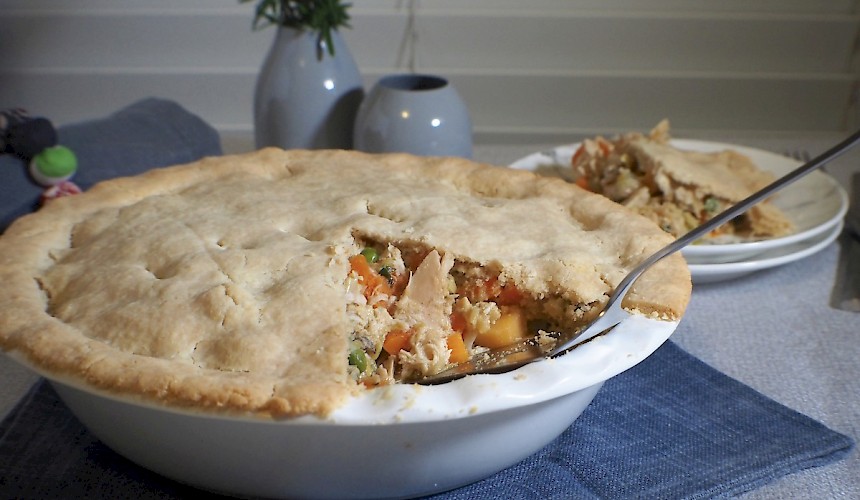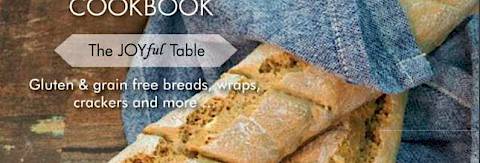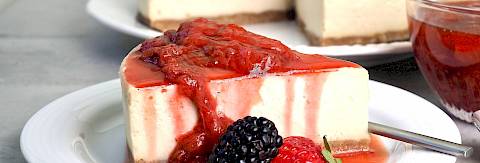
Chicken & Vegetable Pie
- Serves: 4 - 6
- Prep Time: 00:20
- Cooking Time: 00:50
Pie anyone?? My paleo short crust style pastry, covers a tasty filling of chicken and vegetables set in a creamy dairy free sauce, flavoured with a little paprika and thyme. A real comfort food!
Ingredients
* Please click on the green icon next to the ingredients listed below for extra details and helpful information.
- PASTRY:
- 1 1/2 cups almond meal/flour
- 1/2 cup arrowroot flour
- 2 Tbsp coconut flour
- 1/3 tsp pink Himalayan salt
- 1/4 tsp baking soda (bicarb)
- 1/4 cup macadamia oil
- 1/3 cup filtered water
- Melted ghee, or beaten egg to brush over pastry
- PIE FILLING:
- 1 - 2 Tbsp ghee, or coconut oil for frying
- 1 med leek(s), sliced thinly
- 2 med carrot(s), finely diced
- 1 med swede(s), finely diced
- 1 lge celery stick(s), finely diced
- 3 tsp garlic, minced
- 1/2 tsp paprika
- 1/2 tsp dried thyme
- 1 cup chicken broth/stock
- 1/2 cup peas, frozen (optional)
- 1 tsp pink Himalayan salt, or to taste
- 1/4 tsp black pepper, ground, or to taste
- 1 cup coconut cream, thick
- 350g cooked chicken, diced
- 3 Tbsp chopped fresh parsley
- 1 - 1 1/2 Tbsp coconut flour
Directions
To make the pastry: Add the almond meal, arrowroot flour, coconut flour, salt and baking soda to a food processor. Process for 6 seconds to mix the flours. Add the oil and water. Process until the mixture comes together into a soft and pliable dough. Shape into a disc and set aside covered while you prepare the pie filling.
To make the pie filling: Grease a deep pie dish and the rim with macadamia oil or ghee, set aside.
Heat a large (30 - 32cm) frying pan or similar on medium heat. Add ghee, leek, carrot, swede and celery, cook stirring often for 5 minutes, don't allow to brown. (You can add a sprinkle of salt to the vegetables to release more moisture and prevent browning). Add garlic, paprika, thyme and stir through the vegetables, add extra ghee if needed, cook for a further 1 - 2 minutes.
Add chicken broth to the vegetables and bring to a simmer. Cook uncovered for 10 minutes or until the vegetables are tender.
Add peas, salt, pepper and coconut cream, stir through and bring to a light simmer. Stir through diced cooked chicken and parsley. Lightly sprinkle 1 tablespoon of coconut flour evenly over the chicken and vegetable mixture, making sure there are no lumps. Stir through and allow the sauce to thicken to the consistency you like, add extra flour 1 teaspoon at a time if you require a thicker sauce. Remove from heat.
Preheat oven to 180c. Spoon the chicken and vegetables into your prepared pie dish.
Place the dough between 2 sheets of baking paper and roll out a circle to approximately 29 - 30cm in diameter. Remove the top layer of paper, place your hand under the bottom sheet, carefully turn over and place the pastry on top of the pie filling without stretching it, then peel off the paper. Use a knife to trim off the overhang. Press the pastry to the rim of the dish.
Use a fork to make several fork holes over the pie to allow steam to escape. Brush the top with melted ghee or beaten egg and place into oven.
Bake for 30 - 35 minutes or until the pastry is crisp and lightly golden. Allow to sit for 5 - 10 minutes before cutting.
You may also like
almond meal/flour
The most favoured gluten/grain free flour substitute in my kitchen is almond meal. It is finely ground blanched almonds and is also known as almond flour. It has a slightly sweet flavour so you don’t have to add as much sweetener when baking with it. Almond meal/flour is rich in manganese which helps the body heal after injuries and also helps the body break down carbohydrates. Almond flour is also rich in magnesium, which can help control your blood sugar levels. It's rich in vitamin E and other antioxidants, which may help reduce the risk of serious health conditions like cancer, diabetes, stroke, and heart disease. Almonds are also a good source of calcium.
All kinds of nuts can be ground down to make a meal and are excellent for raw cheesecake or pie bases. Nut meals/flours are best stored in airtight containers in the fridge or freezer to prevent them going rancid.
arrowroot flour
Arrowroot is a herb, the roots are cultivated for its starch properties. It is used in my recipes as a thickener and I also like combining it with almond meal to produce a much lighter texture, more like a gluten flour. I find the starch helps to bind the ingredients together. You can substitute tapioca flour, which is made from the dried roots of the cassava plant. Tapioca can be used in baking, it has a slightly sweet flavour. However, I do not recommend thickening with tapioca, as it has a stretchy, gummy texture. Supermarkets only sell in very small containers, which is not cost effective. Purchase from baking specialty stores, health food stores or online. ( When substituting for cornflour in recipes, 2 teaspoons arrowroot = 1 tablespoon cornflour/starch).
coconut flour
Coconut flour is made by drying and grinding the meat of a coconut to a fine texture. Coconut flour is a low-carb flour that's an excellent source of dietary fibre and protein. It's a good grain-free and nut-free alternative but does require a larger amount of liquid than normal when used for baked goods. When replacing in a recipe that calls for wheat flour (or almond meal), use this guide; 1 cup of regular flour = 1/3 cup coconut flour, add an extra egg and an extra 1/3 cup of liquid. It can be used in soups, gravies and stews as a thickener and adds a boost of nutrition. Coconut flour may promote stable blood sugar levels and a healthy heart. In addition, it may have antibacterial properties and aid digestion and weight loss. There are now quite a few brands of coconut flour available and they all seem to perform differently depending on how coarse the texture is. In my recipes, I used Organic Coconut Flour from 'Let's Do Organic' and 'Red Tractor Foods' I like their finer texture.
pink Himalayan salt
Raw pink Himalayan salt crystals is unlike common table salt which can be a highly refined industrial byproduct, otherwise know as sodium chloride. Himalayan salt is completely pure and may naturally balance the body's alkaline/acidity and regulate water content. In addition Himalayan salt helps in the absorption of nutrients from food and contains many trace minerals for healthy cell structure. I purchase fine pink Himalayan crystal salt so I can use it in my shaker and for cooking.
baking soda (bicarb)
Also known as Bicarbonate of Soda or Sodium Bicarbonate and is used as a rising agent in baking, it contains no gluten or grains. I use Bob's Red Mill baking soda as I find it rises better than other brands I've tried.
macadamia oil
Macadamia nut oil is the non-volatile oil expressed from the nut meat of the macadamia tree, a native Australian nut. I avoid heating to very high temperatures but use it extensively for grain free baking at lower temperatures in the oven. Delicious over salads and it's also one of the healthier nuts, as it's higher in Omega 3 oils than other nuts.
filtered water
I feel it's much better for our health if we filter our water. Our tap water contains disinfectants, chlorine and chloramine. Also floride is add which I believe is toxin to our bodies.
ghee
Ghee is a lactose-free ancient superfood. It is made by slow cooking and clarifying butter to remove the milk solids and lactose, it's pure butter fat. You can get the flavour of butter in your cooking without the dairy (please don't consume if you have an allergy to ghee). My favourite brands are Organic Valley Purity Farms or Puresoul grass-fed. It is also very easy to make yourself. Ghee has a high smoke point 485F/250C.
ghee
Ghee is a lactose-free ancient superfood. It is made by slow cooking and clarifying butter to remove the milk solids and lactose, it's pure butter fat. You can get the flavour of butter in your cooking without the dairy (please don't consume if you have an allergy to ghee). My favourite brands are Organic Valley Purity Farms or Puresoul grass-fed. It is also very easy to make yourself. Ghee has a high smoke point 485F/250C.
leek(s)
Leek is a vegetable that belongs to the onion and garlic family. The edible part of the leek is the white base called the stem or stalk, the leaf sheath needs to be removed before eating. Leeks have a sweet, mild onion flavour and are commonly used in stock and soups. Leeks contain many flavonoid anti-oxidants, minerals and vitamins that have proven health benefits.
carrot(s)
This crunchy orange root vegetable is rich in beta-carotene, which is converted into vitamin A in the liver. They are good for the eyes and improve night vision. You get vitamin A and a host of other powerful health benefits from carrots, including cancer prevention, helps prevent infections and heart disease, protects teeth and gums and promotes healthier skin.
swede(s)
The vegetable swede is also know as rutabaga in North America. Swede is a root vegetable that is a similar shape to a turnip but larger, it's flavour is sweeter than a turnip and cream in colour, with some purple on top. The leaves can be eaten as a leaf vegetable. Swede is an excellent substitute for white potato, it can be roasted, baked, boiled, mashed, sauteed and delicious added to soups and stews. Swede can also be thinly julienned or grated uncooked and added to salads or coleslaw. It's a winter vegetable and stores well. Swede is high in vitamin C and provides antioxidants and immune support, helping protect the cells from free radical damage and assists in the thyroid hormone thyroxine. Swedes are rich in beta carotene and also an excellent source of iron, potassium and manganese, a good source of fiber, thiamin, vitamin B6, calcium, magnesium and phosphorus.
celery stick(s)
Both celery stalks and leaves can be used, whole stalks are eaten raw in salads or cooked to give flavour in stews and soups. Raw stalks with the leaves are excellent in your morning smoothie and give you a good dose of vitamin K, B and A, folate, riboflavin and more, plus celery contains several minerals.
garlic
Garlic is a close relative to the onion and has been used throughout history for both medicinal and culinary purposes. In most of my recipes I use minced garlic as I find it distributes better throughout the dish. When in a hurry I use organic minced garlic which I purchase in glass jars and store in the fridge. When garlic powder is needed for a particular recipe, I use 'Simply Organic' brand. Why is garlic so good for us? It is an immune booster, antibiotic, good for the heart, cancer fighter and it's also knew as a weight loss aid (appetite suppressant).
paprika
Paprika is a spice made from grinding dried mild and sweet red chili peppers. Paprika is used to add colour and flavour to a dish. It has a sweet pungent flavour and distinct bitter aftertaste. Even just a small sprinkle of paprika can deliver antioxidants and nutrients like, Vitamin A, E and B6, also iron. I purchase an organic paprika made by 'Simply Organic' (from iherb.com). Paprika is a nightshade.
thyme
Thyme is a perennial herb in the mint family of plants. Thyme has very small leaves that can vary in colour from deep to paler green shades. There are more that 350 known thyme species, common thyme is most popular for cooking but is also used for medicinal purposes. Use fresh or dried leaves to flavour casseroles, soups, stews and sauteed or mashed vegetables. To remove fresh thyme leaves easily, run your fingers down the stem in the opposite direction.
chicken broth/stock
Making homemade chicken broth is a great way to heal Leaky Gut and excellent to drink when unwell. Traditionally broth was made just from bones and simmered for hours to remove the gelatin, marrow and goodness from them. These days vegetables are also added to give extra flavour. By using a slow cooker, making your own broth/stock is so easy. As soon as a roast chicken is eaten, all the bones go into the freezer ready for the next batch of broth. If purchasing store-bought stocks, read the labels as many companies have changed the name of MSG to yeast extract. Organic or free-range brands are available. My Chicken broth recipe is on page 295 of The JOYful Table cookbook. Freeze ice block trays filled with chicken broth for when a small amount is required for a recipe. You can also use an organic concentrated bone broth paste or dehydrated chicken bone broth powder and add them to filtered water.
peas
The green pea grows in a seed-pod, each pod contains several peas. I have chosen to use organic frozen peas for convenience in my recipes, when using fresh you will need to cook a little longer. Peas are starchy but high in fiber, protein, vitamins A, B6, C and K, phosphorus, magnesium, copper, iron and zinc. I also use snow peas and sugar snap peas in my recipes, both are eaten whole in their pod.
pink Himalayan salt
Raw pink Himalayan salt crystals is unlike common table salt which can be a highly refined industrial byproduct, otherwise know as sodium chloride. Himalayan salt is completely pure and may naturally balance the body's alkaline/acidity and regulate water content. In addition Himalayan salt helps in the absorption of nutrients from food and contains many trace minerals for healthy cell structure. I purchase fine pink Himalayan crystal salt so I can use it in my shaker and for cooking.
black pepper, ground
Black and white pepper both come from the fruit of a tropical vine. Black pepper is the cooked and dried unripe fruit, known as a peppercorn and white pepper is from the ripe fruit seed. Pepper is usually coupled with salt, sprinkled over or added to food.
coconut cream
I use this extensively throughout my recipes; from soups to dinners to desserts and cakes. I think it is the best dairy-free alternative. It gives so much flavour and creaminess to a wide variety of dishes. When purchasing in the can read your labels, even some organic brands contain gums and thickeners, choose full-fat not low-fat versions. I use Honest To Goodness organic cream 400ml and Ayam which isn't organic but has no additives or thickeners and is much creamier and thicker than other brands (that's why I love it), it comes in 400ml, 270ml and 140ml size cans.
chicken
Choose grass fed, free-range chicken and organic if available. Chicken is a meat that gets injected with hormones to plumb it up, shop carefully. A good source of protein.
parsley
Parsley would be the most widely used herb worldwide. The two main varieties of this herb are curly parsley with ruffled leaves and Italian parsley with flat leaves. In general flat-leaf parsley has a more robust flavour than the curly leave parsley. Its fresh green flavour and colour can be much more than just a garnish. Both kinds of parsley may be used in cooking. Fresh parsley contains useful amounts of vitamin C, calcium, iron and potassium. Parsley is also high in bioflavonoids and other anticancer compounds.
coconut flour
Coconut flour is made by drying and grinding the meat of a coconut to a fine texture. Coconut flour is a low-carb flour that's an excellent source of dietary fibre and protein. It's a good grain-free and nut-free alternative but does require a larger amount of liquid than normal when used for baked goods. When replacing in a recipe that calls for wheat flour (or almond meal), use this guide; 1 cup of regular flour = 1/3 cup coconut flour, add an extra egg and an extra 1/3 cup of liquid. It can be used in soups, gravies and stews as a thickener and adds a boost of nutrition. Coconut flour may promote stable blood sugar levels and a healthy heart. In addition, it may have antibacterial properties and aid digestion and weight loss. There are now quite a few brands of coconut flour available and they all seem to perform differently depending on how coarse the texture is. In my recipes, I used Organic Coconut Flour from 'Let's Do Organic' and 'Red Tractor Foods' I like their finer texture.
















